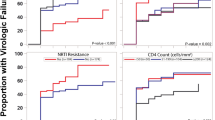Abstract
As HIV treatment becomes more widely available and efficacious, and persons with HIV live longer, considerations for the financial and healthcare impact are of important. The best interval for routine HIV monitoring has been identified as area in which gaps in knowledge exist. The goal of this study is to determine the impact of changing scheduled follow up care for persons with HIV from a 4 to 6 months interval. HIV infected adults with a CD4 count ≥250 cells/μl, and an undetectable HIV viral load (VL) by an ultrasensitive assay for at least 1 year were randomized to routine HIV care at either a 4 or 6 months interval. Subjects were monitored for virological failure, adherence and quality of life (QOL). 142 subjects were enrolled and completed study protocol. Two subjects in the 6 months arm developed virological failure, p value = 0.5. There was no difference in adherence, or QOL scores. Subjects in the 4 months arm had higher rates of HIV visits (8.5/100 vs. 5.2/100 person months, p = 0.01) and non-HIV related visits (9.4/100 vs. 6.0/100 person months, p = 0.01) and were more likely to change antiretroviral regimen (34.8 vs. 15.8 %, p = 0.01). Despite strict inclusion criteria in this relatively short follow up time, 2/142 (1.4 %) subjects developed virological failure and many more had transient detectable VL. While not statistically significant a larger study with longer follow up is needed.
Similar content being viewed by others
References
Palella, F. J., Delaney, K. M., Moorman, A. C., et al. (1998). Declining morbidity and mortality among patients with advanced human immunodeficiency virus infection. New England Journal of Medicine, 338, 853–860.
Centers for Disease Control and Prevention. HIV Surveillance Report, 2012, Vol. 24. http://www.cdc.gov/hiv/library/reports/surveillance. Published November 2014. Accessed 22 Jan 2015.
Harrison, K. M., Song, R., & Zhang, X. (2010). Life expectancy after HIV diagnosis based on national HIV surveillance data from 25 states, United States. Journal of Acquired Immune Deficiency Syndromes, 53, 124–130.
The Antiretroviral Therapy Cohort Collaboration. (2008). Life expectancy of individuals on combination antiretroviral therapy in high-income countries: A collaborative analysis of 14 cohort studies. Lancet, 372, 293–299.
Cooper, D. A. (2008). Life and death in the cART era. Lancet, 372, 266–267.
Antiretroviral Therapy Cohort Collaboration, Zwahlen, M., Harris, R., May, M., Hogg, R., Costagliola, D., et al. (2009). Mortality of HIV-infected patients starting potent antiretroviral therapy: Comparison with the general population in nine industrialized countries. International Journal of Epidemiology, 38(6), 1624–1633. doi:10.1093/ije/dyp306.
Lohse, N., Hansen, A. E., Pedersen, G., Kronborg, G., et al. (2007). Survival of persons with and without HIV infection in Denmark, 1995–2005. Annals of Internal Medicine, 146, 87–95.
Aberg, J. A., Gallant, J. E., Ghanem, K. G., Emmanuel, P., Zingman, B. S., & Horberg, M. A. (2013). Primary care guidelines for the management of persons infected with HIV: 2013 update by the HIV medicine association of the infectious diseases society of America. Clinical Infectious Diseases, 2014(58), e1–e34.
Panel on Antiretroviral Guidelines for Adults and Adolescents. Guidelines for the use of antiretroviral agents in HIV-1-infected adults and adolescents. Department of Health and Human Services. https://aidsinfo.nih.gov/guidelines/html/1/adult-and-adolescent-treatment-guidelines/0. Accessed 7 July 2015.
Günthard, H. F., Aberg, J. A., Eron, J. J., Hoy, J. F., Telenti, A., Benson, C. A., et al. (2014). Antiretroviral treatment of adult HIV infection: 2014 recommendations of the International Antiviral Society-USA Panel. JAMA, 312, 410–425.
Walensky, R. P., Freedberg, K. A., Weinstein, M. C., & Paltiel, A. D. (2007). Cost-effectiveness of HIV testing and treatment in the United States. Clinical Infectious Diseases, 45(Suppl 4), S248–S254.
Schackman, B. R., Gebo, K. A., Walensky, R. P., Losina, E., Muccio, T., Sax, P. E., et al. (2006). The lifetime cost of current human immunodeficiency virus care in the United States. Medical Care, 44(11), 990–997.
Buscher, A. L., & Giordano, T. P. (2010). Gaps in knowledge in caring for HIV survivors long-term. JAMA, 304, 340–341.
Reekie, J., Mocroft, A., Sambatakou, H., EuroSIDA Study Group, et al. (2008). Does less frequent routine monitoring of patients on a stable, fully suppressed cART regimen lead to an increased risk of treatment failure? AIDS, 22, 2381–2390.
Goetz, M. B., Ferguson, M. R., Han, X., McMillian, G., et al. (2006). Evolution of HIV resistance mutations in patients maintained on a stable treatment regimen after virologic failure. Journal of Acquired Immune Deficiency Syndromes, 43, 541–549.
Kendall, M. A., Andersen, J. W., & van Der, H. C. (2006). A reduced frequency visit schedule underreports adverse events that resulted in dose modification or treatment discontinuations in HIV/AIDS clinical trials: ACTG DACS 207. Contemporary Clinical Trials, 27, 287–294.
Julian, F. S., Martin, P., & Erickson, S. R. (2010). Validation of the special projects of national significance adherence tool in HIV/AIDS patients. The Annals of Pharmacotherapy, 44, 1003–1009.
Medical outcomes study HIV health survey (MOS-HIV). John Hopkins Bloomberg School of Public Health. http://www.jhsph.edu/mos-hiv/scoring.html.
Norman, P., Bennett, P., Smith, C., & Murphy, S. (1998). Health locus of control and health behaviour. Journal of Health Psychology, 3(2), 171–180.
Bonner, K., Mezochow, A., Roberts, T., Ford, N., & Cohn, J. (2013). Viral load monitoring as a tool to reinforce adherence: A systematic review. JAIDS Journal of Acquired Immune Deficiency Syndromes, 64(1), 74–78.
Author information
Authors and Affiliations
Corresponding author
Ethics declarations
Conflict of interest
The authors declare that they have no conflict of interest.
Rights and permissions
About this article
Cite this article
Weissman, S., Singh, S., Dykema, S. et al. Randomized Controlled Trial: 4 Month versus 6 Month Monitoring of HIV-infected Patients on Highly Active Antiretroviral Therapy. J Community Health 41, 1044–1048 (2016). https://doi.org/10.1007/s10900-016-0188-4
Published:
Issue Date:
DOI: https://doi.org/10.1007/s10900-016-0188-4




